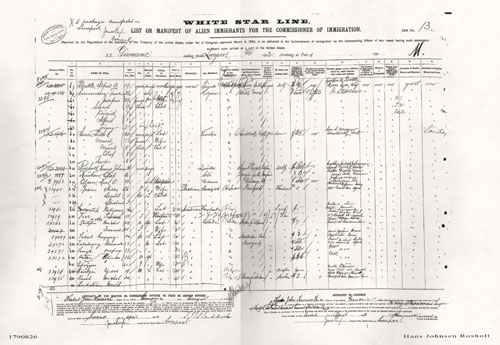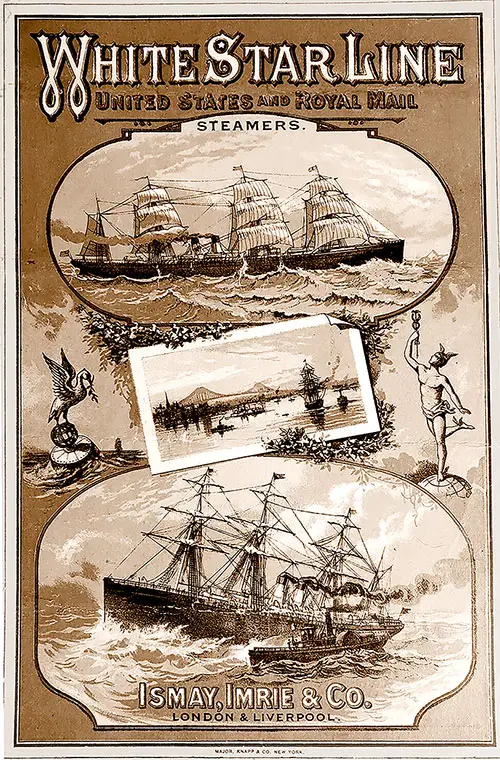Difference Between Passenger Manifests and Passenger Lists
📄 Introduction
At first glance, the terms Passenger Manifest and Passenger List seem interchangeable. Both record names of people traveling by ship — but their purpose, audience, and content were very different. Understanding this distinction is essential for genealogists, historians, and collectors who rely on these documents.

List No. 13 of a Manifest from the White Star Line SS Germanic, 2 April 1902. | GGA Image ID # 2326a23192
📑 Passenger Manifests
Prepared by steamship company officers on behalf of government authorities (later the U.S. Immigration and Naturalization Service), manifests were official records designed for regulation and inspection.
They typically include:
- Ship name & master’s name
- Port of embarkation and arrival
- Date of arrival
- Passenger details such as:
- Name
- Age
- Sex
- Marital status
- Occupation
- Last residence
- Port of arrival
- Final U.S. destination
- Prior visits to the U.S. (if any)
- Relative in the U.S. (name, relationship, address)
🕰️ Timeline of Expanding Details in Manifests
- 1903 – Race added
- 1906 – Personal description & birthplace added
- 1907 – Name & address of nearest relative in country of origin
👉 Why They Matter:
For genealogists, manifests are treasure troves — often the only surviving document that traces an immigrant’s exact origin, relatives, and destination in America.

Front Cover, SS Germanic Saloon Passenger List, Departing 26 June 1889 from New York to Liverpool, Commanded by Captain P. J. Irving. | GGA Image ID # 162ffe1426
🎟️ Passenger Lists
Passenger lists, by contrast, were souvenirs of the voyage, printed for travelers themselves. Distributed in the ship’s saloon after departure, these lists were intended to be keepsakes, marketing tools, and conversation starters.
They often included:
- Names of saloon, cabin, and steerage passengers
- Names of ship’s captain, senior officers, and surgeon
- Company advertisements for future voyages
- Track charts or memoranda of log (sometimes filled in by hand)
- Fleet lists and descriptions of accommodations
- Fine cover artwork or graphic design
👉 Why They Matter:
Passenger lists preserve the social side of transatlantic travel. While they rarely included full details like birthplace or relatives, they reveal who was traveling together, which cabin class they chose, and the design/branding of the steamship line.
| Feature | Passenger Manifest | Passenger List |
|---|---|---|
| Purpose | Government record for immigration control | Souvenir & marketing piece for passengers |
| Prepared by | Steamship officers for INS (later U.S. Customs & Immigration) | Steamship companies, printed and distributed onboard |
| Details Included | Age, sex, marital status, occupation, residence, destination, relatives, race, birthplace | Names of passengers, officers, advertisements, track charts, artwork |
| Format | Handwritten or typed forms, official folios | Printed booklet, often decorative |
| Use Today | Vital record for genealogists tracing family origins | Collectible artifact, historical/social snapshot of travel |
📚 Relevance for Research
Genealogists – Manifests provide family origins and connections; lists give social and cultural context.
Historians – Manifests document migration flows; lists show how companies marketed themselves and who traveled in which class.
Collectors – Passenger lists are prized ephemera, valued for their artwork and rarity.
💬 Final Thoughts
While both documents record ship travelers, they served entirely different audiences: manifests for immigration officials and lists for passengers. Together, they provide a fuller story of migration and ocean travel — one focused on where people came from and went, the other on how the voyage was experienced and remembered.
Unlike the Passenger Manifest which were prepared on behalf of Government Agencies and Immigration officials, Passenger Lists were considered Souvenirs of the Voyage.
Passenger Manifest were Prepared by steamship company officers on behalf of the Immigration and Naturalization Service
Immigration and Naturalization Service passenger manifests (aka passenger lists) include the names of U.S. citizens returning from abroad, foreign visitors, and immigrants.
The manifests typically contain names of vessels and shipmasters, ports of arrival and embarkation, dates of arrival and the following information about each passenger:
- Name
- Age
- Sex
- Marital Status
- Occupation
- Last Residence
- Port of Arrival
- Final Destination in the United States
- If the passenger had been in the US before, When and Where
- If the Passenger was going to join a relative: Relative's Name, Address and Relationship
Beginning in 1903
- Race
Beginning in 1906
- Personal Description
- Birthplace
Beginning in 1907
- Name and Address of alien's nearest relative in country from which he or she came
📚 Teacher & Student Resource
Many of our FAQ pages include essay prompts, classroom activities, and research guidance to help teachers and students use GG Archives materials in migration and maritime history studies. Whether you’re writing a paper, leading a class discussion, or tracing family history, these resources are designed to connect individual stories to the bigger picture of ocean travel (1880–1960).
✨ Educators: Feel free to adapt these prompts for assignments and lesson plans. ✨ Students: Use GG Archives as a primary source hub for essays, genealogy projects, and historical research.
📘 About the Passenger List FAQ Series (1880s–1960s)
This FAQ is part of a series exploring ocean travel, class distinctions, and the purpose of passenger lists between the 1880s and 1960s. These resources help teachers, students, genealogists, historians, and maritime enthusiasts place passenger lists into historical context.
- Why First & Second Class lists were produced as souvenirs.
- How class designations like Saloon, Tourist Third Cabin, and Steerage evolved.
- The difference between souvenir passenger lists and immigration manifests.
- How photographs, menus, and advertisements complement list research.
👉 Explore the full FAQ series to deepen your understanding of migration, tourism, and ocean liner culture. ⚓
📜 Research note: Some names and captions were typed from originals and may reflect period spellings or minor typographical variations. When searching, try alternate spellings and cross-check with related records. ⚓
Curator’s Note
For over 25 years, I've been dedicated to a unique mission: tracking down, curating, preserving, scanning, and transcribing historical materials. These materials, carefully researched, organized, and enriched with context, live on here at the GG Archives. Each passenger list isn't just posted — it's a testament to our commitment to helping you see the people and stories behind the names.
It hasn't always been easy. In the early years, I wasn't sure the site would survive, and I often paid the hosting bills out of my own pocket. But I never built this site for the money — I built it because I love history and believe it's worth preserving. It's a labor of love that I've dedicated myself to, and I'm committed to keeping it going.
If you've found something here that helped your research, sparked a family story, or just made you smile, I'd love to hear about it. Your experiences and stories are the real reward for me. And if you'd like to help keep this labor of love going, there's a "Contribute to the Website" link tucked away on our About page.
📜 History is worth keeping. Thanks for visiting and keeping it alive with me.
